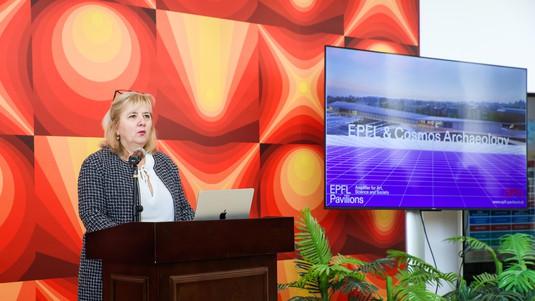A new Chinese step for Cosmos Archaeology

The emblematic building of the Guangdong Science Center in Guangzhou.
After a successful first phase at the Shanghai Astronomy Museum, the Cosmos Archaeology exhibition is coming to the Guangdong Science Center in Guangzhou, the world's largest science museum.
On 10 January, in one of the emblematic petals of the GDSC's vast building, the museum's management and the EPFL Pavilions team invited the Chinese press to discover the second Chinese opening of Cosmos Archaeology. A special visit was also organised for the Swiss consular teams in Guangzhou and Hong Kong.
The exhibition takes visitors on a sensory and immersive journey into the immensity of the cosmos and its many dimensions, with a close-up view of current developments in astrophysics. Originally conceived by EPFL Pavilions and presented on the Lausanne campus in 2022/2023, it weaves a dialogue between art and science, where current astrophysics research, museum representation and artistic creation mutually inspire and merge.
This innovative combination motivated the management of the Guangdong Science Center to host the exhibition. Over an area of almost 1,000m2, it will temporarily join the museum's range of permanent thematic exhibitions, opening up inspiring new perspectives on the place of art in scientific outreach.
Thirteen of the twenty installations that make up this new edition of Cosmos Archaelogy come from the original exhibition curated by EPFL professors Sarah Kenderdine and Jean-Paul Kneib, and most of them come from their laboratories, eM+ and LASTRO. From immersive and interactive installations to kinetic artworks and video works, they invite visitors to explore astrophysics and space exploration through the prism of art, and highlight the excellence of the research carried out at EPFL.
In addition to the original installations, the Chinese iterations of the exhibition see the addition of a myriad of national artistic and scientific proposals, opening up new horizons for an ever more diverse and evolving exhibition.
These new works are the result of a joint curation by the principal curators and the independent Chinese curator Iris Long. They are rooted in research carried out at Tsinghua University and the Chinese Academy of Sciences in Beijing, as well as at the Shanghai Astronomical Observatory, three institutions partnering the exhibition alongside Yuanzhen Culture, Swissnex in China and Présence Suisse.
At its first stop at the Shanghai Astronomy Museum, the exhibition welcomed nearly 73,000 visitors, and was even extended by two months to a total duration of six months, a first for a foreign exhibition in this museum. Scheduled to run for four months in Guangzhou, capital of Guangdong province some 1,500 kilometres from Shanghai, it will reach a wide audience in the heart of the Pearl River Delta megalopolis, as far as Shenzhen and Hong Kong, before heading to Beijing in the summer of 2025.
This exceptional adventure in China marked the first international tour of an original EPFL Pavilions exhibition, and acted as a powerful spark. In its wake, other productions –such as Lighten Up! and Deep Fakes– are also beginning or preparing to meet new audiences abroad, notably at the MIT Museum in Boston in October 2025.















